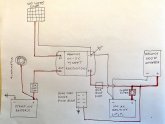Just an FIY on this Renogy DC-DC MPPT charger. Maybe someone else with this can confirm as well. I have this installed in a small van application. I've attached a basic wiring diagram showing how I have this connected.
Recently, I had switched the house battery to the off position while I was doing some work to the vehicle. As I was moving the van around in my driveway, I noticed that my fridge, which is connected to the house fuse panel, was running...even though the house battery was switched off.
When I shut the van off, the fridge lost power and shut off as well. I started the van again, the fridge was off, but after a few seconds, the charger energized the positive side of the house circuit again.
Just to be sure, I completely disconnected the house battery by removing both the positive and negative leads from the battery and it made no difference, the house circuits were energized with the engine running.
This is a problem for obvious reasons, for one, if the inverter was switched on, it would be trying to draw high amps through the undersized wire from the charger and likely blow the 65 amp breaker or the renogy charger will automatically shut down. Either way, that's not ideal. Also, I don't want my house circuits to be energized when the battery switch is turned off, that's the whole point.
I contacted Renogy customer support and they told me that as far as they knew, the charger should not energize the positive lead on the charge side if it wasn't connected to a battery but the person I talked to wasn't sure.
Right now, I'm probably going to install a dual circuit battery switch in place of the single circuit switch that is there now and run the charge lead through one of the two switch circuits so there is no way for the charger to be connected to the house circuits.
Please let me know

what you think.





